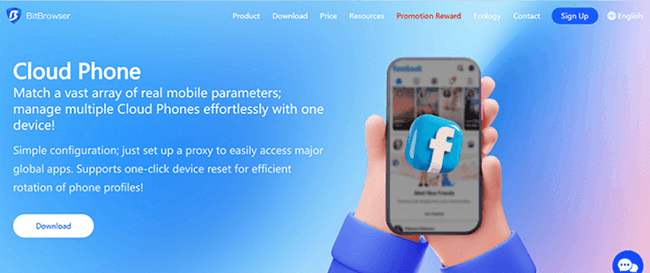
Hot Picks
How to Use BitBrowser for Multiple Bets?

Hot Picks
How to Automate Social Media Accounts

Hot Picks
How to Ensure Stable Facebook Operations When Managing Multiple Accounts
What are Facebook ads? How to conduct effective Facebook advertising marketing?
Time: 2023-09-19 17:30 Click:
In today's digital era, social media has been deeply integrated into people's daily lives, and Facebook, as the most influential social platform in the world, has attracted much attention for its advertising functions. Yet, for many, Facebook ads still seem to be shrouded in mystery. So, what exactly is Facebook advertising? Faced with such a large user group and diverse advertising forms, how can we carry out effective Facebook advertising marketing?

Facebook introduction:
Facebook is one of the world's largest social media platforms. It was founded in 2004 and is headquartered in California, USA. As a platform that connects users around the world, Facebook provides a variety of functions such as social interaction, information sharing, and entertainment. Users can create personal profiles on Facebook, post updates, photos and videos, and stay in touch with friends and family. At the same time, Facebook is also an important channel for companies and brands to carry out marketing activities. It interacts with users and promotes products and services by creating pages and publishing advertisements.
What is Facebook advertising?
Facebook advertising is an online marketing tool that helps companies and brands achieve brand promotion and marketing goals by displaying advertising content on the Facebook platform.

Facebook advertising features:
l Facebook advertising supports a variety of different forms, including image ads, video ads, text link ads, etc. Choose the appropriate advertising form based on the advertising purpose and audience characteristics.
l Facebook provides advertisers with powerful targeted advertising capabilities by virtue of its huge user database. Advertisers can accurately push advertising content to target audiences based on key information such as users' interests, daily behaviors, and geographical location, ensuring the efficiency and accuracy of information transmission.
l Provides real-time advertising effect tracking function for advertisers. Advertisers can easily grasp key indicators such as advertising exposure, click-through rate, conversion rate, etc., and make strategic adjustments based on these data to continuously optimize advertising effects.
l Advertisers can set the budget limit and delivery time of advertising according to budget conditions, and flexibly control advertising costs.
How to conduct effective Facebook advertising marketing?
1. Accurately target target groups
In advertising and marketing, the core principle should be "meeting customer needs rather than promoting one's own products." On the Facebook platform, precise audience targeting is particularly critical. We can segment the audience based on multiple dimensions such as age, user information and behavioral patterns. Age groups can help us divide different consumer groups to more effectively evaluate advertising effects; in-depth understanding of user information is the basis for precision marketing; in addition, Facebook’s algorithm can record users’ interactive behaviors, and we can use this data to reach Target users who are highly matched with the product.
2. Create unique content
Content is the key to attracting users. The content posted on Facebook must be unique and rare in order to stand out from the crowd of ads. Facebook prefers to promote creative and novel content that touches users' emotions and psychology.
3. Real-time monitoring and optimization
In order to ensure advertising effectiveness, we should maintain real-time monitoring of Facebook advertising reports. It is recommended to check the report at least once an hour and conduct in-depth analysis of various data indicators in order to adjust strategies and optimize advertising effects in a timely manner.
4. Follow Facebook advertising guidelines
Facebook’s advertising policies are designed to ensure user experience and platform security. Therefore, we must strictly adhere to these policies. The basis of cooperation is mutual benefit and win-win results. If advertising costs are extremely high, then such cooperation is obviously unsustainable. Ensuring that ad content complies with Facebook's specifications can not only increase ad approval rates, but also reduce unnecessary risks.
5. Diversified investment strategy
Advertising is not just about spending money. We should constantly try different advertising strategies through A/B testing and other methods to find the most effective method. Start with a small budget and gradually expand the scale of delivery to optimize cost-effectiveness. At the same time, we can also try different advertising forms, optimize CPM, CPC and other indicators, and conduct in-depth research on advertising distribution algorithms to find the most suitable delivery method for ourselves.
6. Use multiple accounts for Facebook advertising
Many people would think that managing so many social media accounts must be quite troublesome. Indeed, for owners of multiple accounts, how to manage multiple social media accounts is a common problem. As we all know, if multiple social media accounts are not managed properly, it is very likely that the accounts will be related. In serious cases, Facebook will be banned. Moreover, switching and managing different social media accounts consumes a lot of time and energy, and is also prone to errors. At this time, using social media multi-account management tools becomes an excellent solution.

BitBrowser is a multi-account management platform that can modify and disguise browser fingerprints, allowing users to manage multiple accounts on different social media platforms at the same time without worrying about data leakage or data leakage between accounts. The risk of being associated. When launching cross-channel promotion, you may need to switch between multiple social media accounts to post content, reply to comments, or track interactions. BitBrowser can also help you complete these tasks efficiently without having to log in and out repeatedly.

Want to further improve the operational efficiency of Facebook multi-account advertising? Come and experience RPA and group control functions, which can help you publish messages quickly, save time, improve work efficiency, support multiple accounts to operate together, and avoid association.
Summarize
If you want to achieve good results with your ads on Facebook, you must be brave enough to try and have a long-term vision. This is like playing chess. If you look one step ahead of your opponent, your probability of winning will increase. Well, today’s sharing of Facebook ad placement skills ends here. I believe that as long as you learn the above skills and complete the ad placement process, you will gradually become familiar with it.
Facebook advertising FAQ:
1. The advertising effect was not good, and no obvious results were seen in three days.
Problem overview
When an advertisement fails to achieve the desired effect within three consecutive days, the audience positioning, content display or delivery strategy of the advertisement may need to be adjusted.
solution
1. Accurately target the audience
Target market segmentation: Divide a broad audience into more specific subgroups, and use Facebook's precise targeting capabilities to target specific interests, behaviors, or demographic characteristics.
Analyze user feedback: In-depth study of user interaction and feedback data, identify audience characteristics that are interested in advertising content, and optimize audience positioning.
2. Optimize advertising content
Update creative elements: If the visual or copywriting content in your ad is outdated or doesn’t align with your audience’s interests, consider updating these elements to appeal to your target audience.
Improve interactivity: Inspire your audience to participate by adding interactive elements such as Q&A, polls or interactive images.
Conduct A/B testing: Compare the performance of different ad copy, images, or formats to determine the best way to present your ad.
2. Insufficient advertising coverage, with less than 1,000 exposures the day before
Problem overview
Small advertising coverage may be due to too limited target audience settings or insufficient advertising budget.
solution
1. Broaden the audience scope
Expand geographic areas: If your ads currently only target a specific region, consider expanding to more areas where potential customers are located.
Increase interest and behavior targeting: Incorporate more relevant interest and behavior tags to cover a wider potential audience.
2. Increase advertising budget
Adjust budget allocation: Appropriately increase the daily advertising budget to increase the frequency of advertising display.
Evaluate the return on investment: Before increasing the budget, evaluate the return on investment of the current advertising to ensure the effectiveness of the investment.
Progressive budget growth: Gradually increase your budget and watch for changes in ad coverage and engagement to achieve the best results for your investment.
3. The cost per result has increased, and the cost has increased in the past seven days.
Problem overview
The increase in cost per result may mean that advertising effectiveness is declining, and attention needs to be paid to advertising efficiency and cost control.
solution
1. Optimize delivery time
Analyze the active time of the audience: Use Facebook Insights to understand the active time of the audience and adjust the ad delivery time accordingly.
Set scheduled delivery: Use the timing function to ensure that ads are delivered during the time when the audience is most likely to be online.
2. Conduct A/B testing
Experiment with different combinations of elements: Test different ad copy, images, videos, or call-to-action buttons to find the best performing combination.
Data-driven decision-making: Select the best-performing advertising version for placement based on A/B test results.
4. Advertisements appear frequently and the audience feels resistant.
Problem overview
Frequent display of advertisements may cause audience fatigue and reduce advertising effectiveness.
solution
1. Diversified advertising content
Create multiple ad versions: Design different ad content, including changing images, videos, copy and layout.
Regular rotation of advertisements: Regularly change the advertising content to maintain freshness and reduce audience fatigue.
2. Adjust display frequency
Set a frequency cap: Set a frequency cap for ad display in Facebook Ads Manager to avoid over-displaying to the same audience.
Monitor audience response: Pay close attention to the frequency of ad display and audience feedback, and adjust the frequency limit based on data.
5. Advertising expenditure is lower than the budget, and expenditure only accounts for 70% of the daily budget
Problem overview
Ad spend well below your set daily budget may mean your ads have limited exposure or audience match.
solution
1. Check delivery settings
Remove restrictions: Check your ad settings to make sure there are no unnecessary time or geographic restrictions to expand your ad exposure.
Expand the target audience: If the target audience is too narrow, you can consider appropriately relaxing the conditions to increase the number of potential audiences.
2. Adjust bidding strategy
Increase the bidding level: If the current bidding is too low, you may not be able to get enough exposure opportunities, you can increase the bidding appropriately.
Use automatic bidding: Use Facebook's automatic bidding function to automatically adjust bids based on real-time competition to increase ad exposure.

 Multi-Account Management
Multi-Account Management Prevent Account Association
Prevent Account Association Multi-Employee Management
Multi-Employee Management



